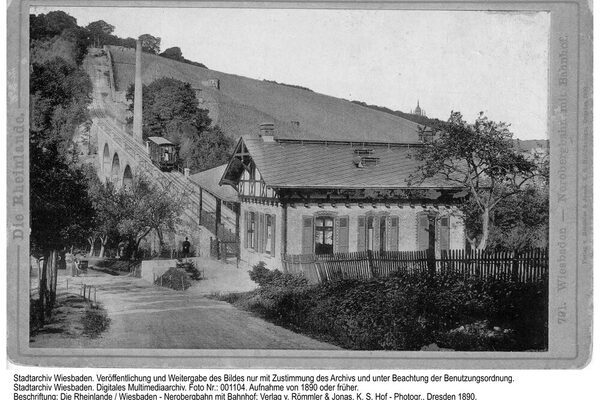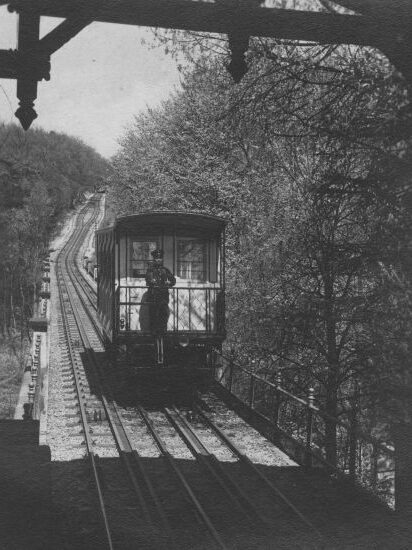Nerobergbahn
The Nerobergbahn, which was opened in 1888, is now one of the landmarks of the city of Wiesbaden.
"Competition boosts business" - this business maxim also applied to the city fathers of the cosmopolitan spa town of Wiesbaden, which had become the meeting place of the world (the nobility and the aspiring bourgeoisie) during the 19th century. The spa guests wanted to be entertained and expected one thing above all: variety. The Neroberg could play an important role in this.
When the invention of rack and pinion operation by the Alsatian Niklas Riggenbach (1817-1899) made it possible to operate railroads safely even on steep gradients, the way was clear for the construction and operation of mountain railroads. The Niederwaldbahn in Rüdesheim was completed in 1884. Assmannshausen followed in 1886 and Bad Ems in 1887. Three of these attractive means of transportation in the immediate vicinity prompted the idea of opening up the Neroberg with a railroad.
There were a number of interested parties, and finally the Baden-Baden entrepreneur Carl Rudolph received the concession to operate a "wire rope rack railroad" to the Neroberg following his application on August 26, 1886. However, the problem was that the terrain meant that the Nero valley had to be bridged with a viaduct, to the declared displeasure of the people of Wiesbaden. The critics were able to refer to Kaiser Wilhelm II, who had expressly criticized the disfigurement of the landscape by Rudolph's structure during a ride.
Construction work began in March 1888. City engineer Richter had to supervise the work. He submitted a two-page list of defects to Rudolph's representatives. Even though the defects were promptly rectified, the city remained suspicious. And when the municipal construction supervisor Baatz informed his superior in writing that the rail superstructure was not being carried out professionally, Richter was prompted to make the biting remark in passing: "So patchwork from the outset."
Finally, on September 25, 1888, the mountain railroad was officially opened. Afterwards, a sumptuous meal brought together all those involved in the construction in the mountain station hall. The Tagblatt gleefully told its readers that at least they had been able to save on ballast water, because the passengers had found it more difficult to get down than hours before. There were long faces when the construction costs were listed: instead of the originally estimated construction sum of 100,000 marks, the costs climbed to 222,352 marks.
What is technically interesting is that the wire rope rack and pinion design is powered exclusively by water ballast. Only the amount of water required to pull the other carriage and passengers up from the bottom station is filled into the tank of the carriage at the top station. The Nerobergbahn covers a difference in altitude of 83 m over a length of 438 m and an average gradient of 19%.
In the first financial year 1888/89, almost 115,000 passengers were transported. In 1889, the Bachstein Consortium (since 1895: Süddeutsche Eisenbahn-Gesellschaft) opened the Nerotal-Rheinufer steam tramway. Carl Rudolph had high hopes for the cooperation with this company. However, the cooperation between the two companies left much to be desired right from the start. In particular, it was not possible to coordinate timetables. Rudolph resigned and sold his railroad to the consortium, which put the mountain railroad into operation in January 1890. The next few years passed without incident. It was only when the inflationary price trend after the First World War led to the collapse of the currency and a single train journey cost 600 marks that the Süddeutsche Eisenbahn-Gesellschaft threw in the towel.
On April 1, 1925, operations were transferred to the city of Wiesbaden, which transferred the railroad to the newly founded Stadtwerke Wiesbaden AG in 1942. The mountain railroad survived the Second World War without major damage. After the end of the war, the American occupation forces confiscated the mountain railroad. Germans were not allowed to ride again until 1947. Over the next few years, the cable car in the rear Nero Valley more or less led a shadowy existence. It was only gradually that the opinion prevailed that the railroad was an excellent monument to the history of the town and its technology. The entire complex is now a listed building of the state of Hesse.
In order to make this historical significance clear to the outside world, the plain "beige" of the two railroad carriages was replaced by a blue and gold color scheme to match the city colors. This was complemented by the banners of the viaduct in the Nassau colors of blue and orange. The centenary celebrations in 1988 were celebrated with large crowds of people and the "birthday child" was put under a lot of strain: the proud statistics showed 25,000 visitors, including guests at a wedding on the railroad. Since then, the Nerobergbahn and the Nerobergbahn Festival have been among the most popular events in Wiesbaden. In 1998, an association of friends and supporters of the Nerobergbahn was formed. In 1999, the city gave it the former toilet house next to the valley station, which was converted into a small but fine mountain railway museum, one of the famous pieces of "street furniture" by the city architect Felix Genzmer.
The 2010 annual accounts showed a sensation: Due to a favorable calendar constellation, Good Friday is the traditional opening day of the season, further increasing public interest and not least the commitment of the employees, the number of passengers exceeded the 250,000 mark.
Literature
125 years of Wiesbaden public transportation 1875-2000. ESWE-Verkehrsgesellschaft mbH (ed.), Wiesbaden 2000.

